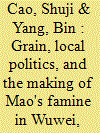|
|
|
Sort Order |
|
|
|
Items / Page
|
|
|
|
|
|
|
| Srl | Item |
| 1 |
ID:
142706


|
|
|
|
|
| Summary/Abstract |
Mao's Great Famine in Wuwei County, Anhui Province, between the years of 1958 and 1960, resulted in the deaths of about 245,000 people, a quarter of the local population. By focusing on grain production and consumption, this article adopts a local perspective to examine the county's official archives and analyse the background, rationale, and processes of local authorities that led to one of the highest death rates in the country. A local perspective provides an empirical microanalysis of the Great Famine; illustrates the complexity of this catastrophe; argues for local factors such as factional struggles, central-local interactions, and the political atmosphere created by the series of pre-1958 campaigns as key to local variations of the disaster; and delivers national implications for viewing Mao's China. Official archives explored in this article reveal that an over-reporting of grain output might have resulted in the Great Famine, but did not necessarily lead to the massive death toll, and that local politics, particularly intra-party factional struggles, intertwined with central-local political interactions, were crucial for the terrible tragedy that ensued in Wuwei, and that the end of this famine resulted not from peasants’ resistance, nor the change of radical polices to moderate ones, but from the decreased demand for grain caused by the massive number of deaths.
|
|
|
|
|
|
|
|
|
|
|
|
|
|
|
|
|
|
|
|
|